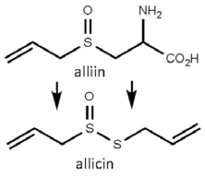 Allium sativum
Allium sativum
garlic
Back to “Culinary herbs: garlic (Allium sativum)”
Allium sativum L. (Alliaceae); knoffel (Afrikaans); suan (Chinese); ail, ail blanc (French); Knoblauch (German); aglio (Italian); gaarikku (Japanese); bawang puteh (Malay); czosnek (Polish); alho (Portuguese); ajo (Spanish)
DESCRIPTION Garlic bulb segments (known as “cloves”) are axillary buds enclosed within a communal papery shell. They are mostly used fresh, less often dried and powdered or steeped in oil. Garlic scapes (suan tai in Sichuan) are commonly used in Chinese cuisine.
THE PLANT A perennial herb with flat leaves arising from an underground bulb. The rounded flower cluster is surrounded by a sheath-like bract. Elephant garlic is a hybrid between garlic and onion with very large bulb segments and a mild flavour.1–3
ORIGIN Garlic is a cultigen of unknown origin dating back to at least 3000 BC. It is perhaps derived from Allium altaicum, a central Asian species.1–3
CULTIVATION Garlic hardly ever produces viable seeds and is therefore propagated by simply planting the cloves. The best planting time is from late summer to autumn. They are spaced 100 to 150 mm (4 to 6 in.) apart and planted at a depth of 50 mm (2 in.). Unlike other species, the bulbs are formed entirely below the soil surface. Light soil and regular feeding with nitrogen fertilizer is recommended. Irrigation should be discontinued when the leaves start to whither.
HARVESTING Bulbs are harvested when the leaves have completely died. They are left in the sun for one day and then brought inside for storage in a cool, well-ventilated place. The bulbs can be sliced and dried to produce garlic flakes or garlic powder.
CULINARY USES The flavour of garlic is characteristic of Italian, French, Spanish and Portuguese cooking but garlic has become popular in most parts of the world. It is typically fried in a little oil as an overture to preparing an excellent dish. It may be pounded and mixed with other ingredients to create seasoning paste (garlic purée), aioli (garlic mayonnaise), pesto, garlic butter and garlic oil. Whole or sliced cloves can be added to soups, stews, fish and meat dishes. Roasted garlic (especially elephant garlic) is sometimes eaten as a side dish.
FLAVOUR COMPOUNDS The strong flavour is due to di-2-propenyl disulphide (diallyl disulphide) as main volatile compound. It is formed from alliin, a non-volatile, odourless sulphoxide characteristic of intact A. sativum bulbs, via allicin, a thiosulphinate intermediate. The levels of thiosulphinate in garlic can be quite high (up to 36 μmol per g wet weight).3,4

NOTES Garlic is used in herbal medicine for its antibiotic action and lipid-lowering effects. The sulphur is excreted mainly through the lungs, hence the noticeable effect on the breath. In Europe and Asia, wild-harvested Allium ursinum (bear’s garlic, wood garlic or ramsons) is making a comeback as culinary herb. It produces about 21 μmol thiosulphinates per g wet weight).4 Care should be taken not to confuse it with the poisonous but superficially similar autumn crocus (Colchicum autumnale). Other garlic-like herbs include A. schorodoprasum (sandleek) from Southeast Asia and A. tricoccum (ramp) from the United States.
1. Mathew, B. 1996. A review of Allium section Allium. Royal Botanic Gardens, Kew.
2. Fritsch, R.M., Friesen, N. 2002. Evolution, domestication and taxonomy. In: Rabinowitch, H.D., Currah, L. (Eds), Allium crop science: recent advances, 5–30. CABI Publishing, New York.
3. Block, E. 2010. Garlic and other alliums. The lore and the science. The Royal Society of Chemistry, Cambridge.
4. Benkeblia, N., Lanzotti, V. 2007. Allium thiosulfinates: chemistry, biological properties and their potential utilization in food preservation. Food 1: 193–201.